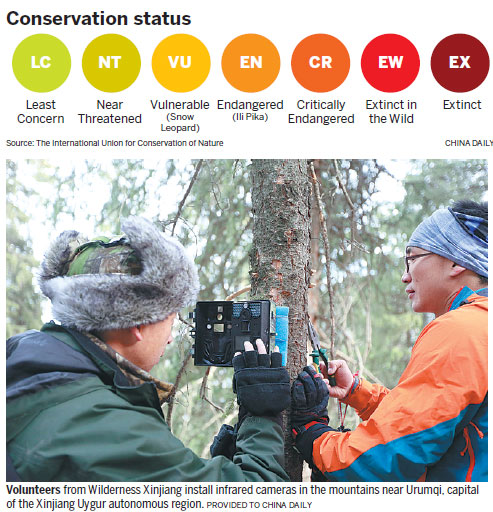
Rising population
According to the Snow Leopard Trust in the United States, there are as many as 6,390 living in the wild. Some experts estimate that about 4,500 of the big cats live in China, according to the International Union for Conservation of Nature.
In September, the union said the number of snow leopards is believed to have risen in the Sanjiangyuan region of the Qinghai-Tibet Plateau in the past 20 years, along with the numbers of major prey species, including the Himalayan blue sheep. The region is the source of three major rivers: the Yangtze; the Yellow; and the Lancang.
Moreover, there are now 3.31 snow leopards per 100 sq km in the Qilian Mountains, which straddle the Gansu-Qinghai border. Surveys conducted in the 1980s suggested densities of less than 1 per 100 sq km, according to the union.
Zhao Xiang, director of the Shanshui Conservation Center's Sanjiangyuan project, said there are about 1,000 of the big cats in the area, making it one of the world's biggest contiguous snow leopard habitats.
Founded in 2007, the NGO, which is based in Beijing, aims to develop community-based grassroots conservation solutions in West China.
On August 15, the center set up a workstation built from removable cargo containers in Angsai, a township in Qinghai's Dzatod county in the core area of the Lancang River section of the Sanjiangyuan National Park. Established in June last year, it was China's first national park.
"We teach the locals to set up camera traps, but they are the experts at picking the best spots because they are familiar with the local wildlife," said Li Yuhan, 23, a volunteer and research student at Peking University who is in charge of the workstation's operations.
Tashi Dongdre, the township head, said, "Local Tibetan herdsmen living in the national park will be trained and paid to work as rangers."
In fact, 42 herdsmen from nearby Nyedo village have already become wildlife inspectors, setting up and maintaining camera traps. So far, the cameras they have set up across an area of 800 sq km have identified 24 snow leopards, Tashi Dongdre said.
"In addition to the big cats, the cameras have recorded the activities of other animals such as leopards, bears, foxes and domestic animals. Every species has a special role in the ecosystem."
As snow leopards are one of the top predators in the area, the rise in their numbers indicates that the local ecosystem is healthy, he added.
Tashi Dongdre said 80 herdsmen from two other villages in the township will join the inspection teams this year to set up enough cameras to monitor an area of 1,800 sq km.


















































